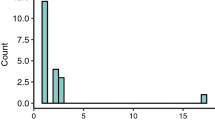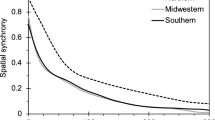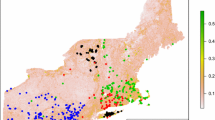Abstract
Geographical variation in the likelihood of biological invasions can be affected by propagule pressure and habitat suitability, which are driven by ecological and social processes. Past studies have empirically quantified the role of drivers by comparing geographical variation in numbers of invading species with variation in candidate factors; however, lack of data has limited empirical studies for individual species. Lymantria dispar (L.), a nonnative forest pest formerly known as gypsy moth, is an exemplar species for exploring invasion drivers because of extensive records on its spread. Since its establishment in eastern United States in 1869, it has been repeatedly introduced into outlying areas, prompting 325 eradication programs from 1972 to 2014. We used these eradication programs as proxies for new establishment events, with the assumption that populations would have established in the absence of eradication treatments. These proxy events were used to quantify the effects of socio-environmental factors on the probability of L. dispar arrival and establishment. Establishment probability was significantly affected by propagule pressure (distance to the previously invaded area, human population size, and the area of source outbreaks) and habitat suitability (climate and availability of host trees). The statistical model developed here can be used to predict invasions and inform surveillance strategies to more efficiently manage these invasions.






Similar content being viewed by others
Data availability
The dataset analyzed during the current study is provided as Supplementary File 3.
References
Allison P (2012) Logistic regression for rare events. Stat Horizons. https://statisticalhorizons.com/logistic-regression-for-rare-events. Accessed 21 May 2019
Andresen JA, McCullough DG, Potter BE, Koller CN, Bauer LS, Lusch DP, Ramm CW (2001) Effects of winter temperatures on gypsy moth egg masses in the Great Lakes region of the United States. Agric Meteorol 110(2):85–100
Baxter PW, Possingham HP (2011) Optimizing search strategies for invasive pests: learn before you leap. J Appl Ecol 48(1):86–95
Bigsby KM, Tobin PC, Sills EO (2011) Anthropogenic drivers of gypsy moth spread. Biol Invas 13(9):2077
Branco M, Nunes P, Roques A, Fernandes MR, Orazio C, Jactel H (2019) Urban trees facilitate the establishment of non-native forest insects. NeoBiota 52:25–46
Bureau of Economic Analysis (2019) Table CAINC1: personal income, population, per capita personal income. https://apps.bea.gov/regional/downloadzip.cfm. Accessed 10 April 2019
Burnham KP, Anderson DR (2002) Model selection and multimodel inference: a practical information-theoretic approach (2nd ed). Springer-Verlag
Clark GF, Johnston EL (2011) Temporal change in the diversity–invasibility relationship in the presence of a disturbance regime. Ecol Lett 14(1):52–57
Colautti RI, Grigorovich IA, MacIsaac HJ (2006) Propagule pressure: a null model for biological invasions. Biol Invas 8:1023–1037. https://doi.org/10.1007/s10530-005-3735-y
Coveney J (2008) FIRTHLOGIT: Stata module to calculate bias reduction in logistic regression. Statistical Software Components
Coveney J (2015) FIRTHLOGIT: stata module to calculate bias reduction in logistic regression. https://econpapers.repec.org/software/bocbocode/s456948.htm
Cook G, Jarnevich C, Warden M, Downing M, Withrow J, Leinwand I (2019) Iterative models for early detection of invasive species across spread pathways. Forests 10(2):108
Dalmazzone S (2000) Economic factors affecting vulnerability to biological invasions. In: Perrings C, Williamson M, Dalmazzone S (eds) The economics of biological invasions. Edward Elgar, Cheltenham, UK, pp 17–30
Dawson W, Moser D, Van Kleunen M, Kreft H, Pergl J, Pyšek P, Weigelt P, Winter M, Lenzner B, Blackburn TM, Dyer EE (2017) Global hotspots and correlates of alien species richness across taxonomic groups. Nat Ecol Evolut 1:0186
Dyer EE, Cassey P, Redding DW, Collen B, Franks V, Gaston KJ, Jones KE, Kark S, Orme CDL, Blackburn TM (2017) The global distribution and drivers of alien bird species richness. PLoS Biol 15:e2000942
Ellenwood JR, Krist Jr FJ, Romero SA (2015) National individual tree species atlas. FHTET-15–01.U.S. Forest Service, Forest Health Protection, Forest Health Technology Enterprise Team
Epanchin-Niell RS, Haight RG, Berec L, Kean JM, Liebhold AM (2012) Optimal surveillance and eradication of invasive species in heterogeneous landscapes. Ecol Lett 15(8):803–812
Epanchin-Niell RS, Brockerhoff EG, Kean JM, Turner JA (2014) Designing cost-efficient surveillance for early detection and control of multiple biological invaders. Ecol Appl 24(6):1258–1274
Epanchin-Niell R (2017) Economics of invasive species policy and management. Biol Invas 19:3333–3354
Firth D (1993) Bias reduction of maximum likelihood estimates. Biometrika 80(1):27. https://doi.org/10.2307/2336755
Gray DR (2004) The gypsy moth life stage model: landscape-wide estimates of gypsy moth establishment using a multi-generational phenology model. Ecol Modell 176(1–2):155–171
Hajek AE, Tobin PC (2009) North American eradications of Asian and European gypsy moth. In: Hajek AE, Glare TR, O’Callagham M (eds) Use of microbes for control and eradication of invasive arthropods. Springer, Dordrecht, pp 71–89
Hajek AE, Tobin PC (2010) Micro-managing arthropod invasions: eradication and control of invasive arthropods with microbes. Biol Invas 12(9):2895–2912
Hauer M, Byars J (2019) IRS county-to-county migration data, 1990–2010. Demogr Res 40:1153–1166
Hufbauer RA, Rutschmann A, Serrate B, Vermeil de Conchard H, Facon B (2013) Role of propagule pressure in colonization success: disentangling the relative importance of demographic, genetic and habitat effects. J Evol Biol 26:1691–1699. https://doi.org/10.1111/jeb.12167
Hui C, Richardson DM, Landi P, Minoarivelo HO, Garnas J, Roy HE (2016) Defining invasiveness and invasibility in ecological networks. Biol Invas 18(4):971–983
Hulme PE (2009) Trade, transport and trouble: managing invasive species pathways in an era of globalization. J Appl Ecol 46(1):10–18
Hulme PE (2011) Biosecurity: the changing face of invasion biology. In: Richardson DM (ed) Fifty years of invasion ecology: the legacy of Charles Elton. Blackwell, Chichester, UK, pp 301–314
Hulme PE (2015) Invasion pathways at a crossroad: policy and research challenges for managing alien species introductions. J Appl Ecol 52:1418–1424
Kean JM, Phillips CB, McNeill MR (2008) Surveillance for early detection: lottery or investment. In: Froud KJ, Popay AI, Zydenbos SM (eds) Surveillance for biosecurity: pre-border to pest management. New Zealand Plant Protection Society Inc., Auckland, New Zealand, pp 11–17
Kean JM, Suckling DM, Sullivan NJ, Tobin PC, Stringer LD, et al. (2020) Global eradication and response database. http://b3.net.nz/gerda. Accessed 15 October 2020
Kalaris T, Fieselmann D, Magarey R, Colunga-Garcia M, Roda A, Hardie D, Cogger N, Hammond N, Martin PT, Whittle P (2014) The role of surveillance methods and technologies in plant biosecurity. In: Gordh G, McKirdy S (eds) The handbook of plant biosecurity. Springer, Dordrecht, pp 309–337
Kearns DN, Tobin PC (2020) Oregon vs. the gypsy moth: forty years of battling an invasive species. Am Entomol 66(3):50–58
King G, Zeng L (2001) Logistic regression in rare events data. Soc Pol Method 27
Liebhold A, Mastro V, Schaefer PW (1989) Learning from the legacy of Leopold Trouvelot. Bull Entomol Soc Amer 35:20–22
Liebhold AM et al. (1995) Suitability of North American tree species to gypsy moth: a summary of field and laboratory tests. Gen Tech Rep NE-211. USDA, Forest Service, Northeastern Forest Experiment Station, Radnor, PA
Liebhold AM, Leonard D, Marra JL, Pfister SE (2021) Area-wide management of invading gypsy moth (Lymantria dispar) populations in the USA. In: Hendrichs J, Pereira R, Vreysen MJB (eds) Area-wide integrated pest management: development and field application. CRC Press, Boca Raton, pp 551–560
Liebhold AM, Bascompte J (2003) The Allee effect, stochastic dynamics and the eradication of alien species. Ecol Lett 6:133–140
Liebhold AM, McCullough DG, Blackburn LM, Frankel SJ, Von Holle B, Aukema JE (2013) A highly aggregated geographical distribution of forest pest invasions in the USA. Divers Distrib 19:1208–1216
Liebhold AM, Berec L, Brockerhoff EG, Epanchin-Niell RS, Hastings A, Herms DA, Kean JM, McCullough DG, Suckling DM, Tobin PC, Yamanaka T (2016) Eradication of invading insect populations: from concepts to applications. Annu Rev Entomol 61:335–352
Lippitt CD, Rogan J, Toledano J, Sangermano F, Eastman JR, Mastro V, Sawyer A (2008) Incorporating anthropogenic variables into a species distribution model to map gypsy moth risk. Ecol Modell 210(3):339–350
Lockwood JL, Cassey P, Blackburn T (2005) The role of propagule pressure in explaining species invasions. Trends Ecol Evol 20(5):223–228
Lockwood JL, Cassey P, Blackburn TM (2009) The more you introduce the more you get: the role of colonization pressure and propagule pressure in invasion ecology. Divers Distrib 15:904–910. https://doi.org/10.1111/j.1472-4642.2009.00594.x
Lonsdale WM (1999) Global patterns of plant invasions and the concept of invasibility. Ecology 80(5):1522–1536
McFadden MW, McManus ME (1991) An insect out of control? The potential for spread and establishment of the gypsy moth in new forest areas in the United States. In: Baranchikov YN, Mattson WJ, Hain FP, and Payne TL (eds) Forest insect guilds: patterns of interaction with host trees. Gen. Tech. Rep. NE-153, US Forest Service, pp 172–186
Padayachee AL, Irlich UM, Faulkner KT, Gaertner M, Procheş Ş, Wilson JR, Rouget M (2017) How do invasive species travel to and through urban environments? Biol Invasions 19(12):3557–3570
Paini DR, Worner SP, Cook DC, De Barro PJ, Thomas MB (2010) Using a self-organizing map to predict invasive species: sensitivity to data errors and a comparison with expert opinion. J Appl Ecol 47:290–298. https://doi.org/10.1111/j.1365-2664.2010.01782.x
PRISM Climate Group (2020) Oregon State University. http://prism.oregonstate.edu
R Core Team (2013) R: a language and environment for statistical computing. R Foundation for Statistical Computing, Vienna. http://www.R-project.org
Rodríguez-Labajos B, Binimelis R, Monterroso I (2009) Multi-level driving forces of biological invasions. Ecol Econ 69(1):63–75
Simberloff D (2009) The role of propagule pressure in biological invasions. Annu Rev Ecol Evolut Syst 40:81–102
StataCorp, (2017) Stata statistical software: release 15. StataCorp LLC, College Station, TX
Tobin PC, Bai BB, Eggen DA, Leonard DS (2012) The ecology, geopolitics, and economics of managing Lymantria dispar in the United States. Int J Pest Manag 58(3):195–210
Tobin PC, Gray DR, Liebhold AM (2014a) Supraoptimal temperatures influence the range dynamics of a non-native insect. Divers Distrib 20:813–823
Tobin PC, Kean JM, Suckling DM, McCullough DG, Herms DA, Stringer LD (2014b) Determinants of successful arthropod eradication programs. Biol Invas 16(2):401–414
Tobin PC, Liebhold AM, Roberts EA, Blackburn LM (2015) Estimating spread rates of non-native species: the gypsy moth as a case study. In: Venette R (ed) Invasive alien species: pest risk modelling and mapping. CABI, Wallingford, UK, pp 131–144
Tobin PC, Robinet C, Johnson DM, Whitmire SL, Bjørnstad ON, Liebhold AM (2009) The role of Allee effects in gypsy moth (Lymantria dispar (L.)) invasions. Pop Ecol 51:373–384
Traveset A, Richardson DM (2014) Mutualistic interactions and biological invasions. Annu Rev Ecol Evolut Syst 45(1):89–113
Turbelin AJ, Malamud BD, Francis RA (2017) Mapping the global state of invasive alien species: patterns of invasion and policy responses. Glob Ecol Biogeogr 26(1):78–92
US Department of Agriculture (2019) Gypsy Moth Program Manual. 2019. https://www.aphis.usda.gov/import_export/plants/manuals/domestic/downloads/gypsy_moth.pdf
US Forest Service (2018) Gypsy moth digest. US Forest Service Forest Health Protection Northeastern Area. https://www.fs.usda.gov/naspf/programs/forest-health-protection/gypsy-moth-digest. Accessed 1 June 2018
Van Kleunen M, Dawson W, Essl F, Pergl J, Winter M, Weber E, Kreft H, Weigelt P, Kartesz J, Nishino M, Antonova LA (2015) Global exchange and accumulation of non-native plants. Nature 525:100–103
Venette RC (ed) (2015) Pest risk modelling and mapping for invasive alien species (vol 7). CABI, Wallingford, UK
Venette RC, Kriticos DJ, Magarey RD, Koch FH, Baker RH, Worner SP, Gómez Raboteaux NN, McKenney DW, Dobesberger EJ, Yemshanov D, De Barro PJ (2010) Pest risk maps for invasive alien species: a roadmap for improvement. Bioscience 60(5):349–362
Whitmire SL, Tobin PC (2006) Persistence of invading gypsy moth populations in the United States. Oecologia 147(2):230–237
Worner SP, Gevrey M (2006) Modelling global insect pest species assemblages to determine risk of invasion. J Appl Ecol 43:858–867. https://doi.org/10.1111/j.1365-2664.2006.01202.x
Acknowledgements
We thank E. Luzader with assistance in geospatial data management, Anthony Man-Son-Hing and Paul Chaloux, USDA APHIS for providing data, and L. Dunlap for assistance with figures, and reviewers for their helpful insights. This work was funded in part by the USDA Forest Service. AML received support from grant EVA4.0, No. CZ.02.1.01/0.0/0.0/16_019/0000803 financed by OP RDE. PCT acknowledges support from the National Science Foundation (DEB-1556111).
Funding
This work was funded in part by the USDA Forest Service. AML received support from grant EVA4.0, No. CZ.02.1.01/0.0/0.0/16_019/0000803 financed by OP RDE. PCT acknowledges support from the National Science Foundation (DEB-1556111).
Author information
Authors and Affiliations
Corresponding author
Ethics declarations
Conflict of interest
The authors have no relevant financial or non-financial interests to disclose.
Additional information
Publisher's Note
Springer Nature remains neutral with regard to jurisdictional claims in published maps and institutional affiliations.
Supplementary Information
Below is the link to the electronic supplementary material.
Rights and permissions
About this article
Cite this article
Epanchin-Niell, R., Lu, J., Thompson, A. et al. Socio-environmental drivers of establishment of Lymantria dispar, a nonnative forest pest, in the United States. Biol Invasions 24, 157–173 (2022). https://doi.org/10.1007/s10530-021-02637-x
Received:
Accepted:
Published:
Issue Date:
DOI: https://doi.org/10.1007/s10530-021-02637-x




